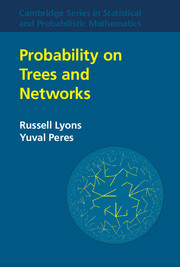Book contents
- Frontmatter
- Contents
- Preface
- Chapter 1 Some Highlights
- Chapter 2 RandomWalks and Electric Networks
- Chapter 3 Special Networks
- Chapter 4 Uniform Spanning Trees
- Chapter 5 Branching Processes, Second Moments, and Percolation
- Chapter 6 Isoperimetric Inequalities
- Chapter 7 Percolation on Transitive Graphs
- Chapter 8 The Mass-Transport Technique and Percolation
- Chapter 9 Infinite Electrical Networks and Dirichlet Functions
- Chapter 10 Uniform Spanning Forests
- Chapter 11 Minimal Spanning Forests
- Chapter 12 Limit Theorems for Galton-Watson Processes
- Chapter 13 Escape Rate of Random Walks and Embeddings
- Chapter 14 RandomWalks on Groups and Poisson Boundaries
- Chapter 15 Hausdorff Dimension
- Chapter 16 Capacity and Stochastic Processes
- Chapter 17 RandomWalks on Galton-Watson Trees
- Comments on Exercises
- Bibliography
- Glossary of Notation
- Index
- Plate section
Preface
Published online by Cambridge University Press: 19 January 2017
- Frontmatter
- Contents
- Preface
- Chapter 1 Some Highlights
- Chapter 2 RandomWalks and Electric Networks
- Chapter 3 Special Networks
- Chapter 4 Uniform Spanning Trees
- Chapter 5 Branching Processes, Second Moments, and Percolation
- Chapter 6 Isoperimetric Inequalities
- Chapter 7 Percolation on Transitive Graphs
- Chapter 8 The Mass-Transport Technique and Percolation
- Chapter 9 Infinite Electrical Networks and Dirichlet Functions
- Chapter 10 Uniform Spanning Forests
- Chapter 11 Minimal Spanning Forests
- Chapter 12 Limit Theorems for Galton-Watson Processes
- Chapter 13 Escape Rate of Random Walks and Embeddings
- Chapter 14 RandomWalks on Groups and Poisson Boundaries
- Chapter 15 Hausdorff Dimension
- Chapter 16 Capacity and Stochastic Processes
- Chapter 17 RandomWalks on Galton-Watson Trees
- Comments on Exercises
- Bibliography
- Glossary of Notation
- Index
- Plate section
Summary
This book is concerned with certain aspects of discrete probability on infinite graphs that are currently in vigorous development. Of course, finite graphs are analyzed as well, but usually with the aim of understanding infinite graphs and networks. These areas of discrete probability are full of interesting, beautiful, and surprising results, many of which connect to other areas of mathematics and theoretical computer science. Numerous fascinating questions are still open.
Our major topics include random walks and their intimate connection to electrical networks; uniform spanning trees, their limiting forests, and their marvelous relationships with random walks and electrical networks; branching processes; percolation and the powerful, elegant mass-transport technique; isoperimetric inequalities and how they relate to both random walks and percolation; minimal spanning trees and forests and their connections to percolation; Hausdorff dimension, capacity, and how to understand them via trees; and random walks on Galton-Watson trees. Connections among our topics are pervasive and rich, making for surprising and enjoyable proofs.
There are three main classes of graphs on which discrete probability is most interesting, namely, trees, Cayley graphs of groups (or, more generally, transitive, or even quasi-transitive, graphs), and planar graphs. More classical discrete probability has tended to focus on the special and important case of the Euclidean lattices, Zd, which are prototypical Cayley graphs. This book develops the general theory of various probabilistic processes on graphs and then specializes to the three broad classes listed, always seeing what we can say in the case of Zd.
Besides their intrinsic interest, there are several reasons for a special study of trees. Since in most cases, analysis is easier on trees, analysis can be carried further. Then one can often either apply the results from trees to other situations or transfer to other situations the techniques developed by working on trees. Trees also occur naturally in many situations, either combinatorially or as descriptions of compact sets in Euclidean space, R d.
In choosing our topics, we have been swayed by those results we find most striking as well as by those that do not require extensive background. Thus, the only prerequisite is basic knowledge of Markov chains and conditional expectation with respect to a σ-algebra.
Information
- Type
- Chapter
- Information
- Probability on Trees and Networks , pp. xiii - xviPublisher: Cambridge University PressPrint publication year: 2017
Accessibility standard: Unknown
Why this information is here
This section outlines the accessibility features of this content - including support for screen readers, full keyboard navigation and high-contrast display options. This may not be relevant for you.Accessibility Information
- 1
- Cited by
